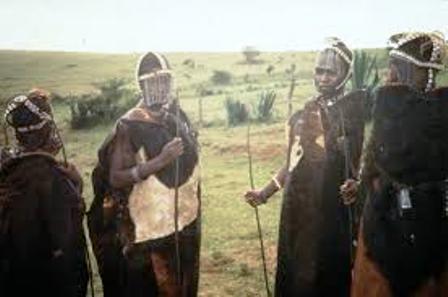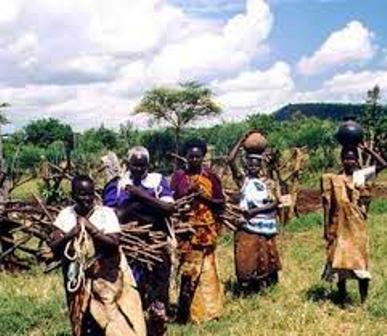The subdivision of this clan is Kap-komuch-long. This video shows and reminds viewers the names of various animals in kalenjin tribe.

Ortinwek Eng Kalenjin Clans In Kalenjin Facebook
The Kipsigis are the largest Kalenjin population with approximately 470000 people.

. The traditional huts resembles Egyptian pyramids totems of clans are used by both Egyptians and Jews showing that they have common phylogeny or ancestry. The number 6358113 individuals as per the Kenyan 2019 census. However among the Tugen this ageset is extinct.
The founder of the clan was called Ki-matage. They are divided into nine culturally and linguistically related clans. Their name Kipkendek may be traced to have been derrived from the Kalenjin word kekenda.
The word kalenjin means I say to you in Nandi. Particularly this animals and plants that regards the sense of belongingCan be Domestic or Wild therefore in the wildest dreams one cannot minced emblem to keeping them as their very own. Israel is derived from two deities IsisAsis and Ra and El the semitic deity.
These clan symbols tiondo normally range from wild animals frog sun birds snake and more. These are some of the Kipsigis clans whose totem is the LION and their various war divisions. Many Kenyans actually believe Kalenjin is a single tribe but the community has a total of 9 sub-tribes.
It wont be hurt as that is considered as a taboo. Their totem is the crested crane while their war division is Kebeni. Kalenjin love their cows and land.
The three rested on their sides and continued thus for a long time. Location of the Kalenjin People. The population of the Kalenjin Tribe is about 3 million being the fourth largest ethnic group in Kenya.
She had two sons who later took up the name and made it a clan. It was first allocated. Archaeological excavation at several Sirikwa holes reinforces this image.
They are an ethnic grouping of eight culturally and linguistically related groups or tribes. Kalenjin culture defined their identify. Komut-Ket Kap-Kuton Kip-Mologek and Kap-Mochoek.
Houses were built on the outside fence with the door facing inward toward the stock enclosure. They also attached a lot of respect to their family animal. According to the Kenyas 2009 census the Kalenjin has a population of 4967328 people making it the third largest group in Kenya after the Kikuyu and the Luhya.
Kalenjins were mainly practised farminghunting and gathering. There he found or created Ilet who lived on earth in those days with an elephant whom the Kalenjin believed to be the father of all animals and an Okiek who was the father of all mankind. For fear of a recurrence the community decided to retire the age-set.
Among the some Kalenjin peoples an age-set called Maina exists. The Kipsigis by extension the Kalenjin were a martial society hence the boriosiek war divisions or regiments into clans were grouped. The Kalenjins clans are each identified by an animal that helped prevent inbreeding since marriage within clan was prohibited.
KAP-CHEBUMBWEK Kebeni war division KAP-CHEPALUNGU Kipkaige war division KAP-KESOGEK Kipkaige war division. Clans were usually exogamous ie one had to marry outside of one. Their present-day homeland is Kenyas western highlands and the Rift Valley.
The Kipkendek clan or Sololo is one of the popular clan among the Kalenjin tribe. In a much respected way kalenjin adore this cheerfully. One day Ilet noticed man turn his head and he became suspicious but took no action.
Marakwet is actually a blanket term for the Endo groups and the Talai. They have been divided into 11 culturally and linguistically related tribes. The different clans are the Nandi Terik Tugen Keiyo Marakwet Pokot Sabaot and the Kipsigis.
The Kalenjin people can be found in the Rift Valley escarpment of Kenya. They grow millet maize and now tea and sorghum. Although the sun is not an animal it has a clan and is regarded as a totem in the same sense as a lion.
Although not all kalenjins are Nandi the name kalenjin has. The last animal comes with several rules. Kalenjin has strong political social and spiritual institution.
They are also best known for their prowess in athletics where they. Kalenjin people had totems in form of animals. As their totem believed the Elephants would not attack them when.
Kalenjin are most known community whose ancestral origin is traced back from Egypt. Kalenjin legend has it that the Sirikwa people used these as cattle pens to guard their animals at night. As well as holding certain animals to be sacred religions have also adopted the opposite attitude that certain animals are unclean.
For example those who had an elephant Leopard Lion etc. Together the Kalenjin comprise Kenyas fourth-largest ethnic group. The following are some of Clans among Kalenjin people.
Kipsigis Nandi Keiyo Marakwet Sabaot Pokots Tugen Terik and Ogiek. The Kalenjin are a group of Southern Nilotic tribes descending from Maliri people thus related to Daasanach of Ethiopia They are indigenous to East Africa residing mainly in what was formerly the Rift Valley Province in Kenya. The Kalenjin are sometimes considered as a tribe made up of many clans.
The Kalenjin are a group of Southern Nilotic tribes descending from Maliri people thus related to Daasanach of Ethiopia They are indigenous to North and East Africa residing mainly in what was formerly the Rift Valley Province in. The largest sub-group is the Nandi. The order is roughly as given below.
The Kalenjin live primarily in Kenya. A Totem is a object a plant or animal that serves as a emblem of a family or clan and often serves as a reminder of its ancestry. This video shows various totems and their tribe names in kalenjin.
They speak Kalenjin languages which belong to the Nilotic language family. The clan has several sub-clans for instance. This tribe is traditionally pastoral and is made up of about 10 sub-groups.
Their totem is a bee and this characterize their ever hardworking traits. It is called kimaget Jackal. The kalenjin say that in their migratory journey in a wild far country they were pursued by an enemy.
Legend has it that the members of this ibindo were wiped out by the Keiyo their cousins in war. Clan totemic symbols ranges from planets birds wild animals amphibians reptiles and insects. Nandi elders claimed that crested crane Kongony is the leader.

Mike Lagatt On Twitter Jumaf3 All Kalenjin Clans Are Named After Animals Tuanze Kulipa Https T Co Hjufemlarw Twitter

Details Of Kipsigis Tribe And Their Culture In Kenya

Details Of Kipsigis Tribe And Their Culture In Kenya

Kalenjin Phrases And Vocabularies Posts Facebook

Origin Of Clans Among The Kipsigis People Kalenjin Media

The Origin Of Kenya S Kalenjin Nation Considered Lost Israelites Kajiado News Update


0 comments
Post a Comment